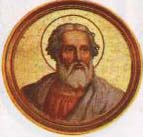Pope Soter
| Saint Soter | |
|---|---|

| |
| Birth name | ??? |
| Papacy began | 167 |
| Papacy ended | 174 |
| Predecessor | Anicetus |
| Successor | Eleuterus |
| Born | ??? Fondi, Lazio, Italy |
| Died | 174 (?) Rome, Italy |
Pope Saint Soter was a second century bishop of Rome, born in Fondi, Lazio, Italy. The name Soter derives from the Greek word "¤â¤ë¤ä╬«¤ü" (s┼Źt─ôr), meaning savior, or deliverer. The successor of Anicetus, he held the office about eight years and was succeeded by Eleutherus, his deacon.
Soter is attested to have provided generous support to various other churches, especially that of Corinth. Little else is known of him with certainty, although it is likely that in his time Rome began to celebrate the yearly Easter feast. During his episcopacy, the Roman church continued to be challenged by "heretical" teachings, especially Gnosticism, Marcionism, and Montanism.
Soter's dates, like all of the popes during this period, are uncertain, due to conflicting sources. His reign began 162-168 and ended in 170-177. His feast day was traditionally marked on April 22, the same as Pope Caius (283-296). They were celebrated jointly in the Tridentine Calendar and in the successive versions of the General Roman Calendar until 1969, after which they are omitted.
Soter was traditionally believed to have suffered martyrdom. However, the Roman Martyrology does not give him this title, since his death as a martyr is not historically confirmed.
Biography
The Liber Pontificalis relates that Soter hailed from the city of Fondi in Italy, located between Rome and Naples in the region of Lazio (formerly Latium) and that his father's name was Concordius. His father was of Greek origin. Although little else is known about Soter, a letter from Bishop Dionysius of Corinth testifies to him as a man of significant charity. In his letter, preserved by Eusebius, Dionysius praises Soter and the Roman church for their generosity, saying:
From the beginning it has been your custom to do good to all the brethren in many ways, and to send alms to many churches in every city, refreshing the poverty of those who sent requests, or giving aid to the brethren in the mines, by the alms which you have had the habit of giving from old, Romans keeping up the traditional custom of the Romans; which your blessed Bishop Soter has not only preserved, but has even increased, by providing the abundance which he has sent to the saints, and by further consoling with blessed words with brethren who came to him, as a loving father his children (Eusebius, Church History IV.24).
Dionysius' letter has long been appealed to by Catholics as evidence of Rome's longstanding preeminence in the early church, as well as its exemplary leadership and service. Dionysius further states that he intends to have Soter's own letter to the Corinthians read publicly in church, as was done previously with the letter of Clement, thus affording the epistle semi-scriptural status. Unfortunately, Soter's letter no longer exists.
It is probable that in Soter's time, Rome instituted a special feast in celebration of Easter, which it had not done previously. The church at Rome no doubt also continued its struggle against the teachings of Marcion and other more overtly Gnostic teachers such as Valentinus. Its attitude toward the prophetic-ecstatic movement of Montanism during this time is uncertain. The Roman church may have begun to treat the Montanists as heretics as early as the time of Soter's predecessor Anicetus or as late his successor, Eleutherus.
The circumstances of Soter's death are unknown. The Roman Martyrology says of him simply: "Saint Soter, Pope, whom Dionysius of Corinth praises for his outstanding charity towards needy exiled Christians who came to him, and towards those who had been condemned to the mines."
| Roman Catholic Popes | ||
|---|---|---|
| Preceded by: Anicetus |
Bishop of Rome Pope 167ÔÇô174 |
Succeeded by: Eleuterus |
ReferencesISBN links support NWE through referral fees
- Chapman, John. Studies on the Early Papacy. Port Washington, NY: Kennikat Press, 1971. ISBN 9780804611398.
- Duffy, Eamon. Saints and Sinners: A History of the Popes. New Haven, CT: Yale University Press, 2002. ISBN 0300091656.
- Fortescue, Adrian, and Scott M. P. Reid. The Early Papacy: To the Synod of Chalcedon in 451. Southampton: Saint Austin Press, 1997. ISBN 9781901157604.
- Kelly, John N. D., and Michael J. Walsh. The Oxford Dictionary of Popes. New York, NY: Oxford University Press, 2006. ISBN 978-0198614333
- Loomis, Louise Ropes. The Book of Popes (Liber Pontificalis). Merchantville, NJ: Evolution Publishing. ISBN 1889758868
- Lopes, Antonino. The Popes: The Lives of the Pontiffs through 2000 Years of History. Futura Edizioni, 1997. ISBN 978-8887181005
- Maxwell-Stuart, P. G. Chronicle of the Popes: The Reign-by-Reign Record of the Papacy from St. Peter to the Present. New York, NY: Thames and Hudson, 1997. ISBN 0500017980.
- Walsh, Michael J. An Illustrated History of the Popes: Saint Peter to John Paul II. Bonanza Books, 1980. ASIN B000O9Y9I6
This article incorporates text from the Catholic Encyclopedia, a publication now in the public domain.
| |||||||||||||
Credits
New World Encyclopedia writers and editors rewrote and completed the Wikipedia article in accordance with New World Encyclopedia standards. This article abides by terms of the Creative Commons CC-by-sa 3.0 License (CC-by-sa), which may be used and disseminated with proper attribution. Credit is due under the terms of this license that can reference both the New World Encyclopedia contributors and the selfless volunteer contributors of the Wikimedia Foundation. To cite this article click here for a list of acceptable citing formats.The history of earlier contributions by wikipedians is accessible to researchers here:
The history of this article since it was imported to New World Encyclopedia:
Note: Some restrictions may apply to use of individual images which are separately licensed.